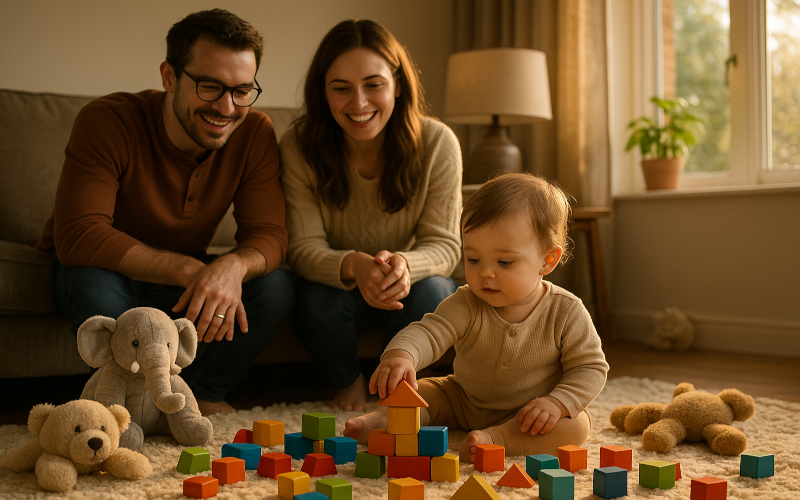
Toy Safety for Toddlers: A Parent’s Guide to Safer Playtime
If you’ve ever watched your toddler play and thought, “Wow, that block is going straight into their mouth,” you’re not alone. Welcome to toddlerhood, where curiosity knows no bounds and toy safety becomes your new full-time hobby.
This guide is your friend, your sanity-saver, and your reminder that you’re not being overprotective you’re being smart. Let’s talk about how to keep playtime fun and safe.
Why Toy Safety Matters More Than Ever
Toddlers are natural explorers. They chew, pull, bang, and test the durability of every object they can get their little hands on. Unfortunately, what looks like fun to them can be a hazard if we’re not careful.
-
Choking risks are the number one concern. Anything small enough to fit through a toilet paper roll can get lodged in their airway.
-
Toxic materials (like lead paint or unsafe plastics) can be harmful, especially with toys that go straight in the mouth.
-
Sharp edges, loose parts, or poor design can lead to cuts, bruises, or worse.
According to the U.S. Consumer Product Safety Commission (CPSC), more than 200,000 toy-related injuries are treated in emergency rooms each year. That’s a stat worth remembering.
“When in doubt, bigger is better. If a toy looks small enough to swallow, skip it.”
Choosing Age-Appropriate Toys
Every toy on the market comes with an age recommendation. These aren’t just marketing gimmicks they’re based on child development and safety standards.
-
Under 3 years old: Avoid small parts, balloons, marbles, magnets, and button batteries.
-
Ages 3–5: Toys can be more complex, but still avoid choking hazards.
-
5+ years: More freedom, but still supervise for sharp objects or electronics.
If you’re unsure, test it with the toilet paper roll rule: if it fits, it sits (on the shelf, not in your child’s toy bin).
Materials Matter: Go Non-Toxic
When it comes to toddlers, everything is a teething toy. That means materials matter.
-
Look for BPA-free plastics or, better yet, wooden toys finished with non-toxic paint.
-
Avoid toys with strong chemical smells as they’re red flags for unsafe materials.
-
Fabric toys? Make sure they’re machine washable to keep germs at bay.
Check out HealthyChildren.org (from the American Academy of Pediatrics) for an excellent breakdown of safe materials.
💡 Affiliate pick: See safe, non-toxic toddler toys here → Amazon’s toddler toy safety collection.
Staying Alert: Toy Recalls and Updates
Even the safest-looking toys can end up being recalled. Keeping up to date is a must.
-
Visit the CPSC Recall Database regularly.
-
Sign up for email alerts so you don’t miss critical news.
-
If you buy secondhand toys, double-check they haven’t been recalled.
Nothing takes the fun out of playtime faster than realizing your child’s favorite toy is on a recall list.
The Ultimate Toy Safety Checklist
Before bringing a new toy home, run through this quick checklist:
-
✅ No small detachable parts
-
✅ Rounded edges (no sharp corners)
-
✅ Non-toxic paint and finishes
-
✅ Strong, durable build (toddlers = crash test engineers)
-
✅ Washable or easy to clean
-
✅ Proper labeling and certification
Stick this on your fridge it’ll save you headaches.
Storage and Supervision
Toy safety doesn’t stop at the store. How you store and supervise matters too.
-
Use toy bins with lids to keep small parts out of reach.
-
Regularly inspect toys for wear and tear.
-
Always supervise toddlers during play. Even the “safest” toy can cause a mishap if left unsupervised.
Next time you shop, try this: pick one toy that’s developmentally enriching (like a shape sorter) and one that’s just plain fun (like a soft stuffed animal). This balance keeps kids engaged and safe, while keeping you sane.
Remember!
-
“If it fits through a toilet paper roll, it’s not a toddler toy.”
-
“Toy safety is less about bubble-wrapping your child and more about making smart, confident choices.”
Toy safety for toddlers isn’t about being paranoid it’s about giving your child the freedom to explore safely. By choosing age-appropriate, non-toxic, and well-constructed toys, and by staying on top of recalls, you’re setting your child up for safe and joyful play.
So go ahead and let your toddler bang blocks, chew on rings, and giggle at stuffed animals. Just make sure you’ve done your homework first.
Author Bio
Earnest Sherrill is a dedicated writer, parent, and digital publisher focused on family wellness, safe parenting, and making the digital age work for everyday families. As founder of multiple niche sites and newsletters, he blends humor, research, and practical advice to help parents raise kids safely and happily. When he’s not writing, you’ll find him testing toys with his grandkids or chasing fishing lines on the lake.
